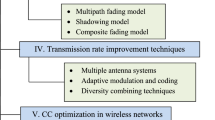Abstract
This paper investigates the issue that whether the jamming in the second time slot should be utilized for secure two-way amplify-and-forward relay systems. Particularly, a more realistic and severe scenario is considered: no information related to the eavesdroppers is available and the number of eavesdroppers is not less than that of legitimate nodes. The impact of the jamming modes on the secure performance is carried out and reveals a novel insight that one-time-slot jamming outperforms two-time-slot jamming in high SNR region, i.e., one > two. A low-complexity and robust joint relay and partial jammer selection criterion is proposed, in which only jamming in the first time slot is employed and no wiretap information is required. Simulation results highlight the effectiveness of our design.






Similar content being viewed by others
Notes
Note that the collisions may occur during the timer-based selection process. However, as pointed out in [12] that the probability of collision can be made arbitrary small, close to zero.
References
Zhao, Z., Peng, M., Ma, Y., Li, Y., Yang, C., & Wu, Y. (2015). Cooperative transmissions in 5G large-scale relay systems: How to keep a balance between performance and complexity? Journal of Signal Processing Systems, 2015, 1–17.
Upadhyay, P. K., & Prakriya, S. (2011). Performance of analog network coding with asymmetric traffic requirements. IEEE Communications Letters, 15(6), 647–649.
Zhang, C. S., Ge, J. H., Li, J., Rui, Y., & Guizani, M. (2015). A unified approach for calculating outage performance of two-way AF relaying over fading channels. IEEE Transactions on Vehicular Technology, 64(3), 1218–1229.
Chen, G., Tian, Z., Gong, Y., Chen, Z., & Chambers, J. (2014). Max-ratio relay selection in secure buffer-aided cooperative wireless networks. EEE Transactions on Information Forensics and Security, 9(4), 719–729.
Zou, Y., Wang, X., Shen, W., & Hanzo, L. (2014). Security versus reliability analysis of opportunistic relaying. IEEE Transactions on Vehicular Technology, 63(6), 2653–2661.
Ibrahim, D. H., Hassan, E. S., & El-Dolil, S. (2015). Relay and jammer selection schemes for improving physical layer security in two-way cooperative networks. Computers & Security, 50, 47–59.
Chen, J., Zhang, R., Song, L., Han, Z., & Jiao, B. (2011). Joint relay and jammer selection for secure two-way relay networks, IEEE International Conference on Communications (ICC2011), pp. 1–5.
Chen, J., Zhang, R., Song, L., Han, Z., & Jiao, B. (2012). Joint relay and jammer selection for secure two-way relay networks. IEEE Transactions on Information Forensics and Security, 7(1), 310–320.
Ding, Z., Xu, M., Lu, J., & Liu, F. (2012). Improving wireless security for bidirectional communication scenarios. IEEE Transactions on Vehicular Technology, 61(6), 2842–2848.
Jiang, F., Zhu, C., Peng, J., et al. (2015). Joint relay and jammer selection and power control for physical layer security in two-way relay networks with imperfect CSI. Wireless Personal Communications, 85(3), 841–862.
Nguyen, B. V., & Kim, K. (2015). Secrecy outage probability of optimal relay selection for secure AnF cooperative networks. IEEE Communications Letters, 19(12), 2086–2089.
Bletsas, A., Khisti, A., Reed, D. P., & Lippman, A. (2006). A simple cooperative diversity method based on network path selection. IEEE Journal on Selected Areas in Communications, 24(3), 659–672.
Gao, H., Yuen, C., Ren, Y., Lv, T., & Wei, L. (2015). Distributed user scheduling for MIMO-Y channel. IEEE Transactions on Wireless Communications, 14(12), 7123–7139.
Acknowledgements
This work was supported by the National Natural Science Foundation of China (61501347), the Project Funded by China Postdoctoral Science Foundation (2015M580816), the Fundamental Research Funds for the Central Universities (JB160111), the “111” Project (B08038).
Author information
Authors and Affiliations
Corresponding author
Rights and permissions
About this article
Cite this article
Zhang, C., Ge, J. Partial Jamming for Secure Two-Way Relay Systems Without Wiretap Information: One > Two. Wireless Pers Commun 95, 4013–4024 (2017). https://doi.org/10.1007/s11277-017-4037-2
Published:
Issue Date:
DOI: https://doi.org/10.1007/s11277-017-4037-2




